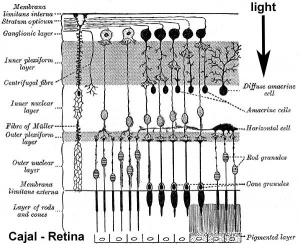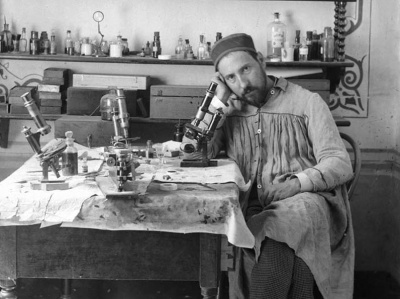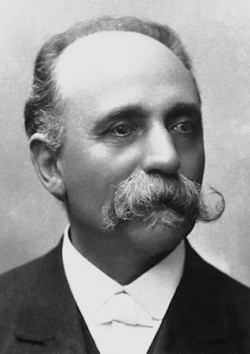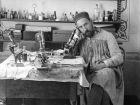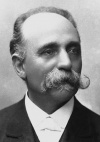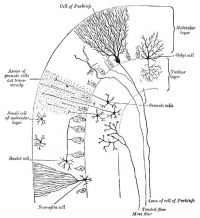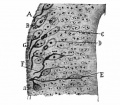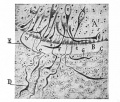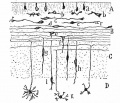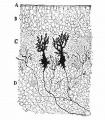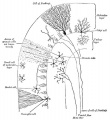Embryology History - Santiago Ramón y Cajal
Introduction
Santiago Ramon y Cahal (1852 - 1934) and Camillo Golgi (1843 - 1926) jointly received the Nobel Prize in Medicine in 1906 "in recognition of their work on the structure of the nervous system."
A Spanish researcher who used then new histology Golgi staining techniques to identify the cerebellum cellular structure. His work was a turning point in our understanding of the structure of the brain, that until then had been described as a "syncytium" and not consisting of discrete cellular elements. For this research and other work on defining the structure of the brain he, along with Camillo Golgi (1843 - 1926), received the 1906 Nobel Prize in Medicine.
- Links: 1899 Human Sensory Cortex 1904 - A Brief History of Science | Retina | History - Early 20th Century | Category:Cajal
From the 1990 Science book review.[1]
- "The neuroanatomist Santiago Ramon y Cahal might be considered something of a pioneer in the autobiographical genre, his straightforwardly titled Recuerdos de Mi Vida having appeared, in two volumes, in 1901 and 1907. The work was translated into English in 1937 and published as volume 8 of the Memoirs of the American Philosophical Society, itself now a long-standing sponsor of such works."
Santiago Ramon y Cahal in laboratory portrait.
| Camillo Golgi |
|---|
| Camillo Golgi (1843 - 1926) developed the histology silver staining technique, the basis of Cajal's study of the brain.
Golgi today though is best known for the cellular organelle that bears his name, the Golgi apparatus. |
| Embryologists: William Hunter | Wilhelm Roux | Caspar Wolff | Wilhelm His | Oscar Hertwig | Julius Kollmann | Hans Spemann | Francis Balfour | Charles Minot | Ambrosius Hubrecht | Charles Bardeen | Franz Keibel | Franklin Mall | Florence Sabin | George Streeter | George Corner | James Hill | Jan Florian | Thomas Bryce | Thomas Morgan | Ernest Frazer | Francisco Orts-Llorca | José Doménech Mateu | Frederic Lewis | Arthur Meyer | Robert Meyer | Erich Blechschmidt | Klaus Hinrichsen | Hideo Nishimura | Arthur Hertig | John Rock | Viktor Hamburger | Mary Lyon | Nicole Le Douarin | Robert Winston | Fabiola Müller | Ronan O'Rahilly | Robert Edwards | John Gurdon | Shinya Yamanaka | Embryology History | Category:People | ||
|
Cerebellum
| Historic Embryology | ||||
Much of the basic structure of the cerebellum comes the historic histological studies and staining of Ramón Cahal (1852 - 1934) and Camillo Golgi (1843 - 1926). Cahal was a Spanish researcher who used the then new histology Golgi staining techniques to identify the cerebellum cellular structure. His work was a turning point in our understanding of the structure of the brain, that until then had been described as a "syncytium" and not consisting of discrete cellular elements. For this research and other work on defining the structure of the brain he, along with Camillo Golgi (1843 - 1926), received the 1906 Nobel Prize in Medicine.
| ||||
Historic Drawings
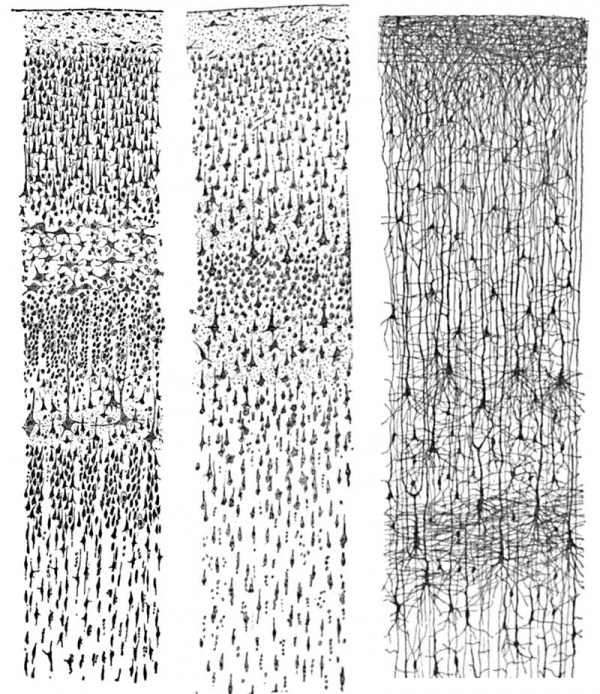
| ||
| adult human visual cortex | adult human motor cortex | infant human (1.5 month) |
| Nissl-stain | Nissl-stain | Golgi-stain |
Cajal bodies
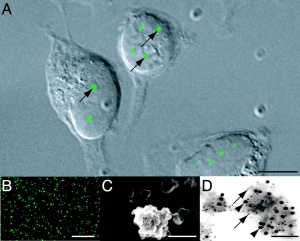
(CB) Ramon y Cajal originally identified these small (20-25 nm) nuclear membraneless organelles in cells, they have various suggested functions and are localized to the nucleolar periphery or within the nucleoli. They contain both newly assembled small nuclear ribonucleoproteins (snRNPs, for pre-mRNA splicing) and small nucleolar ribonucleoproteins (snoRNPs, for ribosomal RNA processing) particles. See also the review.[3]
Proteins associated with two neural genetic abnormalities are associated with these bodies.
- Spinal muscular atrophy SMN1 (5q13) encodes a 38 kD protein located in Cajal bodies.
- Fragile X Syndrome protein (FMRP) isoforms 6 and 12 (ISO6 and 12) proteins located in Cajal bodies. [4] Fragile X Syndrome (FXS) is the most common form of inherited mental retardation and autism.
References
- ↑ Livingston K. (1990). Recollections of My Life. Santiago Ramon Y Cajal. MIT Press, Cambridge, MA, 1989. xxvi, 638 pp., illus. Paper, $16.95. Translated from the third Spanish edition (1923). Reprint, 1937 edition; The Never-Ceasing Search. Francis O. Schmitt. American Philosophical Society, Philadelphia, 1990. xvi, 399 pp., illus. $30. Memoirs of the American Philosophical Society, vol. 188; Song Among the Ruins. William J. Schull. Harvard University Press, Cambridge, MA, 1990. x, 305 pp. + plates. $25; Science, Churchill, and Me. Hermann Bondi. Pergamon, New York, 1990. x, 142 pp. + plates. $30; A Very Decided Preference. Life with Peter Medawar. Jean Medawar. Norton, New York, 1990. 256 pp., illus. $19.95; Landau. The Physicist and the Man. I. M. Khalatnikov, Ed. Pergamon, New York, 1989. viii, 323 pp., illus. $100. Translated from the Russian by J. B. Sykes; Chandrasekhara Venkata Raman. A. Jayaraman. Allied East-West Press, New Delhi, 1989 (available from the author, AT&T Bell Laboratories, Murray Hill, NJ 07974). xiv, 214 pp. + plates. $10; paper, $8. Science , 249, 571-2. PMID: 17735292 DOI.
- ↑ Ogg SC & Lamond AI. (2002). Cajal bodies and coilin--moving towards function. J. Cell Biol. , 159, 17-21. PMID: 12379800 DOI.
- ↑ Gall JG. (2003). The centennial of the Cajal body. Nat. Rev. Mol. Cell Biol. , 4, 975-80. PMID: 14685175 DOI.
- ↑ Dury AY, El Fatimy R, Tremblay S, Rose TM, Côté J, De Koninck P & Khandjian EW. (2013). Nuclear Fragile X Mental Retardation Protein is localized to Cajal bodies. PLoS Genet. , 9, e1003890. PMID: 24204304 DOI.
Garrison FH. (1929). Ramón y Cajal. Bull N Y Acad Med , 5, 482-508. PMID: 19311679
RAMON Y CAJAL S. (1952). Structure and connections of neurons. Bull Los Angel Neuro Soc , 17, 5-46. PMID: 14944970
Search Pubmed
Search Pubmed: Ramon y Cahal
External Links
External Links Notice - The dynamic nature of the internet may mean that some of these listed links may no longer function. If the link no longer works search the web with the link text or name. Links to any external commercial sites are provided for information purposes only and should never be considered an endorsement. UNSW Embryology is provided as an educational resource with no clinical information or commercial affiliation.
- Nobel Prizes Nobel Prize in Medicine 1906 | Cajal Biography
- Book Review Nerve endings: the discovery of the synapse
Glossary Links
- Glossary: A | B | C | D | E | F | G | H | I | J | K | L | M | N | O | P | Q | R | S | T | U | V | W | X | Y | Z | Numbers | Symbols | Term Link
Cite this page: Hill, M.A. (2024, April 28) Embryology Embryology History - Santiago Ramón y Cajal. Retrieved from https://embryology.med.unsw.edu.au/embryology/index.php/Embryology_History_-_Santiago_Ram%C3%B3n_y_Cajal
- © Dr Mark Hill 2024, UNSW Embryology ISBN: 978 0 7334 2609 4 - UNSW CRICOS Provider Code No. 00098G

